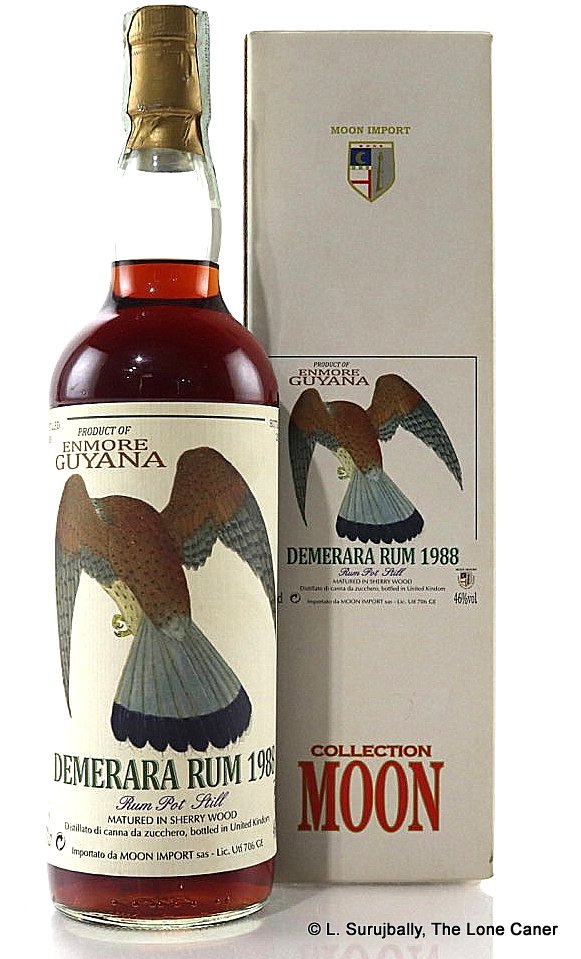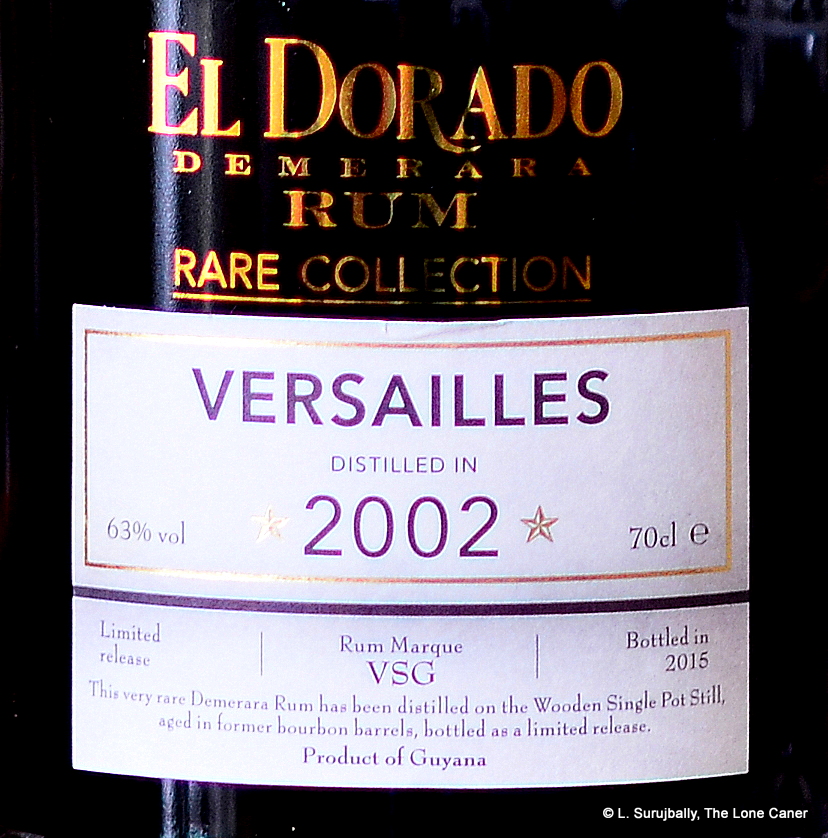One of the German independent Our Rum & Spirits’ earlier bottlings is the Guyanese Enmore from 1990 which was bottled in 2015, a year after they released their first one (an 11 YO Diamond). It’s a respectable 24 (European) years old, a solid anvil-dropping 61.2% ABV, 178 bottles, and of course, it’s not from the Enmore coffey but from the Versailles single wooden pot still, which was the still-in-residence at Enmore Estate back then, before everything got shipped off to Diamond around 2000 in The Great Consolidation.
By now I’ve been trying various single-still offerings from Guyana for years, usually made by the indies but also, more recently, by DDL themselves. One thing I’ve observed is that Enmore distillate tends to be a shade more elegant and a touch light, the Port Mourant is dark and rich and rarely bad at any age, while Versailles is somewhat more brutal, is raw and assertive, and takes real skill to bring to its full potential. This may be why there are so many bottlings of the other two in circulation, while Versailles is rather more rare, and used more in Demerara rum blends (along with the PM).
That said, it’s always interesting how a rum made three decades ago and aged for so long holds on to its character. The nose here opens with fresh, damp sawdust and varnished lumber. One would expect a certain mellowness of age, a smoothening out of roughness, yet the rum still noses like a product much younger, retaining a thin crisp vibrancy, with notes of glue, acetones, licorice, smoke, well-polished old leather, faint salted caramel, and a few ripe stoned fruits for some edge. Oh, and some sweet dusting of brown sugar and cinnamon.
The palate is where such forceful strength comes into its own: here that presents as dry, woody and very sharp, like a whole bag of Red Rose loose black tea dumped into a very small pot and then doused with some brown sugar and a tin of evaporated milk (we called it “bush tea” back in the day – I once fed my little brother some when he was doing exams and he stayed up for two days straight on the stuff). Vanilla, molasses, caramel and licorice are the dominant flavours. Subtler hints of acetone, soya and brininess become noticeable after a while, and some very faint floral and fruity hints waft around without ever making a serious statement. Unsurprisingly it concludes with a finish as long as a polar summer sunset, but it’s slim pickin’s: wood and tannins, some salted caramel, anise, and again, a grain or two of cinnamon.
Well, I have to say that for something sporting a jock of such high ABV and age, I did expect something more complex and pungent on the attack. While undeniable strong and hard on the senses, in the flavour department the rum packs all the verve and panache of an eunuch’s underwear. The opening notes are simple, almost lackluster; then the palate overwhelmed with wood and varnish, and I was reminded of the Old Man Spirits’ Uitvlugt, which also showed off a lot of oomph but had little serious sensory action beyond the obvious. It suggests to me that the cask was not very active, and what you got was what the raw distillate brought to the party, not what the barrel itself was able to add.
Be that as it may, I can’t give the final product a completely failing grade, because let’s admit it, at that strength you’re getting a lot, the tastes that are there aren’t bad, and if it takes a bit more effort to tease out more interesting and extra aromatic notes, well, so be it. All the stats – the ABV, the age, the country, the still – are just excuses to get us to engage our senses with the rum itself, a Diamond-based Duke Nukem that’s all action and no reflection, desiring no deeper meaning for itself beyond the test of your ability to cope with it. Speaking for myself, I can’t say that’s entirely a bad thing.
(#847)(84/100)
Background History
Our Rum & Spirits, located in the small town of Hildesheim just south of Hanover in north-central Germany, is among the first of the new wave of modern German independents, however small they might be. Back in 2014 when the company bottled its first release (a Guyanese 2003 11 YO from Diamond), the rum business was a sideshow to Christian Nagel’s restaurant which served rums (and some other spirits) as part of the menu.
The next logical step was to bottle what he himself would like to have – at the very least if he had a barrel, he wouldn’t run out quite so fast. The reception to the initial Diamond was so good that others followed, and two years later he was exhibiting at the Berlin Rum Fest: he’s now a regular and a medal winner there (several times) and has multiple bottlings from Guyana, Barbados, Panama and Jamaica. For me he’s a regular stopping point whenever I’m there, if only to chat and say hello.
By early 2018 he removed his spirits activities to different premises from the restaurant and now acts as both independent and distributor; this aspect of his work became successful enough that in June of 2021, gave up the gastronomy business altogether.




 This is not the first Demerara rum that the venerable Italian indie bottler Moon Import has aged in sherry barrels: the superb
This is not the first Demerara rum that the venerable Italian indie bottler Moon Import has aged in sherry barrels: the superb 
 Opinion
Opinion
 Bristol, I think, came pretty close with this relatively soft 46% Demerara. The easier strength may have been the right decision because it calmed down what would otherwise have been quite a seriously sharp and even bitter nose. That nose opened with rubber and plasticine and a hot glue gun smoking away on the freshly sanded wooden workbench. There were pencil shavings, a trace of oaky bitterness, caramel, toffee, vanilla and slowly a firm series of crisp fruity notes came to the fore: green apples, raisins, grapes, apples, pears, and then a surprisingly delicate herbal touch of thyme, mint, and basil.
Bristol, I think, came pretty close with this relatively soft 46% Demerara. The easier strength may have been the right decision because it calmed down what would otherwise have been quite a seriously sharp and even bitter nose. That nose opened with rubber and plasticine and a hot glue gun smoking away on the freshly sanded wooden workbench. There were pencil shavings, a trace of oaky bitterness, caramel, toffee, vanilla and slowly a firm series of crisp fruity notes came to the fore: green apples, raisins, grapes, apples, pears, and then a surprisingly delicate herbal touch of thyme, mint, and basil. 
 My own preference has always been for the stern elegance of the Port Mourant, and the Enmore coffey still produces rums that are complex, graceful and sophisticated when done right. But the Versailles still is something of an ugly stepchild – you’ll go far and look long to find an unqualified positive review of any rum it spits out. I’ve always felt that it takes rare skill to bring the rough and raw VSG pot still profile to its full potential…none of the familiar indies has had more than occasional success with it, and even Velier never really bothered to produce much Versailles rum at the height of
My own preference has always been for the stern elegance of the Port Mourant, and the Enmore coffey still produces rums that are complex, graceful and sophisticated when done right. But the Versailles still is something of an ugly stepchild – you’ll go far and look long to find an unqualified positive review of any rum it spits out. I’ve always felt that it takes rare skill to bring the rough and raw VSG pot still profile to its full potential…none of the familiar indies has had more than occasional success with it, and even Velier never really bothered to produce much Versailles rum at the height of  There has been occasional confusion among the stills in the past: e.g. the
There has been occasional confusion among the stills in the past: e.g. the 
 Thinness of the nose aside, the palate took something of a ninety degree left turn. It felt thicker, richer, with the glue and furniture polish notes receding, yet what emerged was a rum that seemed over-oaked, and very dry, very crisp. What fruits there were – and there were some, mostly raisins, pears, unripe apples and green mangoes – were of the mouth puckering kind, quite tart, accompanied by orange peel, nutmeg, cardboard or drywall, and something that reminded me of the dustiness of a drought-stricken backyard. The strength was fine for what it was – not low enough to make it a mild crowd-pleaser, not so strong as to make it an assault on the tongue, so on that level it succeeded just fine. The finish gave up more of those tart fruity sensations, oak notes, some pepper and cooking herbs (thyme and parsley)…yet overall, it somehow failed to cohere really well, and the whole experience was deflated by its relative lack of voluptuousness that either some more ageing or some time in tropical climes might have ameliorated.
Thinness of the nose aside, the palate took something of a ninety degree left turn. It felt thicker, richer, with the glue and furniture polish notes receding, yet what emerged was a rum that seemed over-oaked, and very dry, very crisp. What fruits there were – and there were some, mostly raisins, pears, unripe apples and green mangoes – were of the mouth puckering kind, quite tart, accompanied by orange peel, nutmeg, cardboard or drywall, and something that reminded me of the dustiness of a drought-stricken backyard. The strength was fine for what it was – not low enough to make it a mild crowd-pleaser, not so strong as to make it an assault on the tongue, so on that level it succeeded just fine. The finish gave up more of those tart fruity sensations, oak notes, some pepper and cooking herbs (thyme and parsley)…yet overall, it somehow failed to cohere really well, and the whole experience was deflated by its relative lack of voluptuousness that either some more ageing or some time in tropical climes might have ameliorated.








